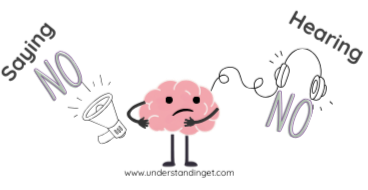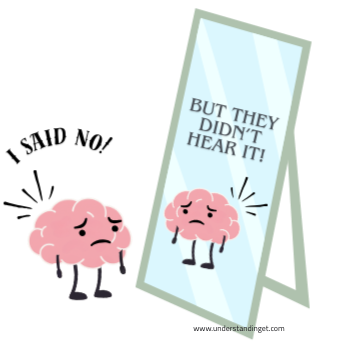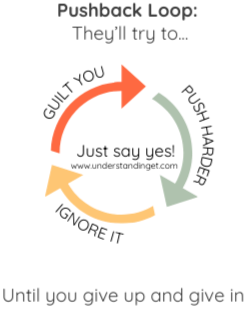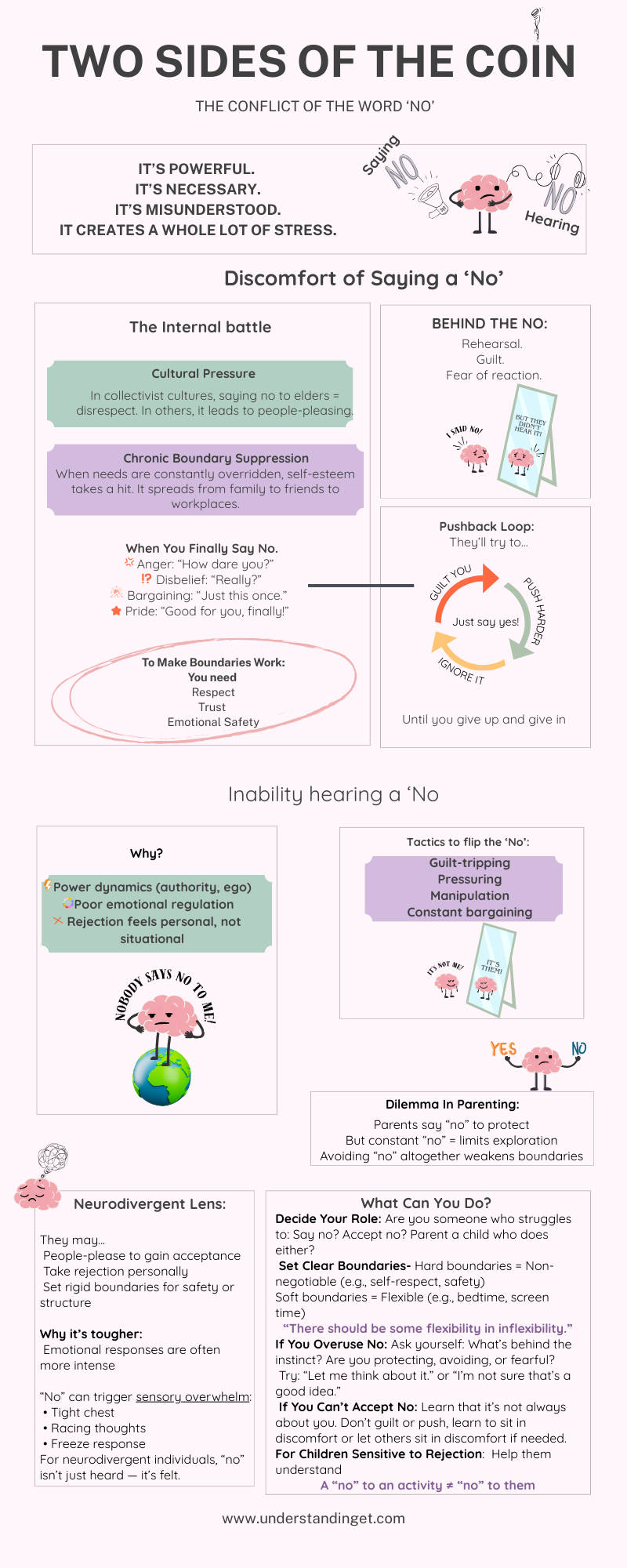TWO SIDES OF THE COIN: THE CONFLICT OF THE WORD ‘NO’
- Sukanksha Bajaj
- Aug 27
- 5 min read
Updated: Aug 28
Saying No. Hearing No. Why It’s So Hard.

It’s powerful.
It’s necessary.
It’s misunderstood.
It creates a whole lot of stress.
Can you guess it?
Two letters — No.
Have you gotten angry at hearing it? At times, scared? Nervous? Sometimes relieved or happy as well? What is it about this word that evokes so many emotions?
One side: Saying 'No'
I was staying with a friend and I asked her 2-year-old for a hug. She said ‘no,’ and I didn’t mind — we settled for a high five. My friend said it was such a relief because when family meets her, they don’t listen to her ‘no,’ and she gets upset.
This makes me wonder: when someone sets a boundary with a ‘no,’ why is it so difficult for us to accept it? The way we respond to someone else’s 'no' often reflects our own emotional regulation. Do we see it as rejection, disrespect, or something else?
It depends on culture. In collectivist societies, saying no to someone older is often seen as disrespectful. Many people struggle to set boundaries with elders. In individualistic societies, we call them ‘people pleasers.’ But it doesn’t end within the family. It spreads to friends, workplaces — they become the polite ones. Their needs are constantly undermined, leading to lower self-esteem.

Then one day, they take the courage to say no. And the reactions can be varied:
Anger – How dare they say no?
Disbelief – How could they say no?
Bargaining – Oh, come on, it’s such a small task.
Pride – They finally stood up for themselves.
What people don’t realise is the emotional marathon individuals go through before they reach that point. The stress, the mental rehearsal, the worry about the other person's reaction, not wanting to hurt someone or themselves. But most importantly, how they will keep saying no in the situation.

Many people feel that they can be worn down, made to feel
guilty, or simply ignored. Others might keep pushing until the person either keeps reinforcing their boundary or gives up and ends up saying yes.
It happens a lot when you are trying to quit your job — all the layers of management try to convince you to stay. Or when you want to leave a toxic relationship. Sticking to your decision requires resolve.
However, at times there's the other side we all struggle to receive a 'No.' Has that ever happened to you?
The Flip Side: Hearing 'No.'
The inability to accept a ‘no’- this can be equally chaotic. It causes stress not only for the individual but for everyone around them.

The reasons for this can vary—perhaps they hold a position of authority, lead the household, or simply feel entitled. Often, they take the ‘no’ not as a boundary, but as a personal affront, interpreting it as an attack on their dignity or authority.

As mentioned earlier, individuals can manipulate, pressurize, or bargain to convert a ‘no’ into a ‘yes,’ because they lack the emotional regulation or maturity to accept boundaries.
So what do you really need to be able to accept or say a 'No' in any relationship?
Respect. Trust. Emotional safety.
These three are the foundation for any healthy boundary.
Respect means acknowledging someone’s autonomy without questioning it.
Trust allows us to believe that the boundary isn't meant to harm us.
Emotional safety ensures we can voice or receive a 'no' without fear of judgment or retaliation.
The ability to respect and create healthy boundaries needs to be taught from a very young age.
How does this apply to parenting?
While understanding the reasoning behind the newer parenting approaches where the word ‘no’ is avoided, I agree with it to some extent. But have you met someone whose first response is always ‘no’ the moment you make a suggestion? That’s self-protection, and it applies to parenting too.
Parents often say,
"No, don't do that!"
This is to protect the child because they know the consequences. But allowing the child to explore is crucial for cognitive and emotional development.
That said, it doesn’t mean we avoid the word altogether. Some boundaries need to be non-negotiable. Children must learn to accept a ‘no.’ That’s where the concept of consent begins.
This complexity becomes even more pronounced when we consider neurodivergent children and adults, who may experience boundaries through entirely different lenses.
How does this apply to neurodivergent children/ adults?

They may fall into all categories:
They might be people pleasers, constantly violating their own boundaries to be accepted.
They might struggle to take a ‘no,’ interpreting rejection as personal.
They might draw hard boundaries, either due to inflexibility or self-protection.
For them, these challenges may be even more heightened. For some, especially neurodivergent individuals, saying or hearing ‘no’ isn’t just emotional—it’s felt physically: tight chest, racing thoughts, freeze response. These bodily reactions can make the experience even more overwhelming and difficult to navigate.
What should you do?
Decide –
which side of the coin are you on?
Someone who struggles to say no?
Someone who struggles to accept it?
Parenting/teaching a child who falls into either?
Set boundaries – Every individual needs boundaries.
Some are non-negotiable (‘hard boundaries’) like self-respect, emotional or physical safety, personal space.
Others can be flexible ('soft boundaries') based on context — letting your child play a bit longer, or sleeping in on weekends. It could be used as rewards as well.
"There should be some flexibility in inflexibility."
Overusing no – If you're someone who tends to say no often, pause. Ask yourself why: Are you protecting yourself or your child? Are you afraid of taking risks or leaving your comfort zone? You could be closing doors.
Use phrases like:
“Let me think about it.”
“I don’t know if that’s a good idea.”
These give you space to reflect before defaulting to a no.
Inability to take a no – If you or someone around you struggles with hearing ‘no,’ it can have lasting consequences. Maybe they’ve never been told no before. Maybe they equate rejection with a flaw in their character.
It’s not always your responsibility. You don’t have to feel guilty. Let them sit in that discomfort especially if they are crossing a boundary.
If it’s a child sensitive to rejection, support them. Help them understand that a no isn’t a rejection of them, just the situation.
A friend saying no to ice cream doesn’t mean they don’t want to hang out — it just means they don’t want ice cream.
We’ve all been in one of these roles. And yes, there are nuances. This isn’t about a one-time scenario, but about the overall pattern. At the heart of it, saying 'no' and hearing it—isn’t about rejection. It’s about respect.
Knowing which side of the coin you tend to fall on is the first step toward growing your sense of boundaries and honouring others’ as well.
Here’s a quick breakdown to help you reflect on the power and polarity of the word “No” — from both sides of the coin.

I’d love to hear from you — which side of the coin do you find harder: saying no or hearing it? What’s helped you navigate that discomfort? Drop a comment or share this with someone who needs to hear: No isn’t rejection. It’s respect.
Which side of the ‘no’ coin do you relate to more?
I struggle to say no
I struggle to accept no
Both, depending on the situation
Neither — I’ve worked through it
You can vote for more than one answer.


Never thought there was a whole study on a simple word NO . A real eye opener and thought provoking article .